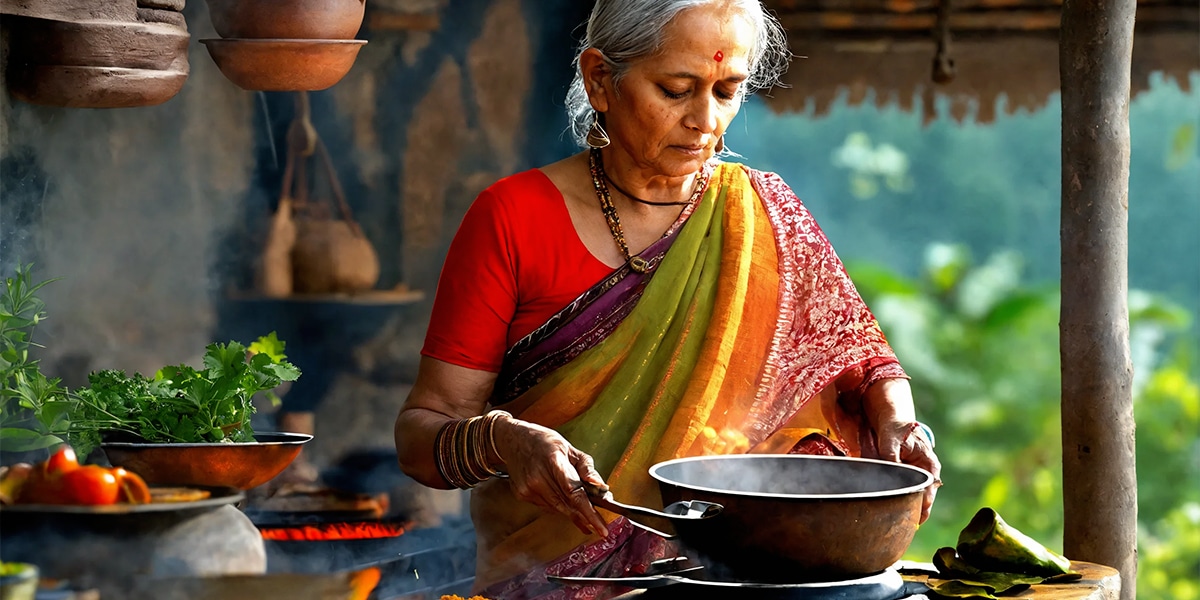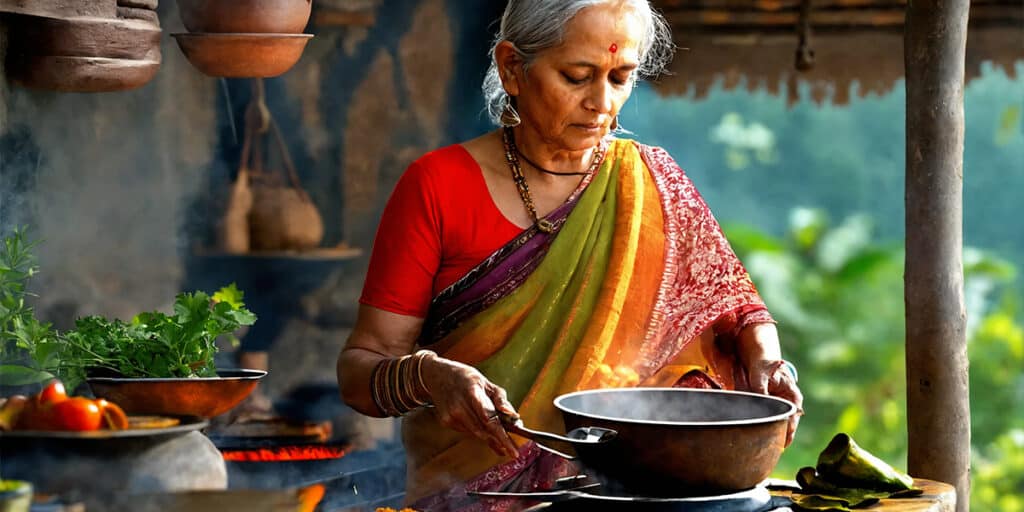Diabetes management is a crucial aspect of millions of lives worldwide, with diet playing a pivotal role in controlling blood sugar levels. Ayurvedic cooking, with its emphasis on balance and natural ingredients, offers a unique approach to diabetes management.
This article delves into how integrating Ayurvedic principles and spices into daily cooking can aid in the effective management of diabetes, promoting wellness and balance from the inside out.
The Essence of Ayurvedic Cooking
Ayurvedic cooking is not just about preparing food; it’s a holistic approach that considers the nutritional, medicinal, and energetic properties of ingredients to promote health and balance within the body. Ayurveda categorizes food into six tastes: sweet, sour, salty, bitter, pungent, and astringent, each playing a role in balancing the doshas (body energies: Vata, Pitta, and Kapha) and supporting digestive health.
Benefits of Ayurvedic Spices in Diabetes Management
- Turmeric (Curcumin): Known for its anti-inflammatory properties, turmeric can help reduce insulin resistance.
- Cinnamon: This spice can improve insulin sensitivity and lower blood sugar levels.
- Fenugreek: Rich in soluble fiber, fenugreek seeds can aid in blood sugar control by slowing down digestion and carbohydrate absorption.
- Ginger: Ginger can help with glycemic control and has anti-inflammatory effects.
Incorporating Ayurvedic Practices in Daily Meals
Incorporating Ayurvedic practices into daily meals transcends the mere act of eating and transforms it into a nurturing ritual that promotes balance, wellness, and harmony within the body, especially for individuals managing diabetes. Ayurveda, with its rich heritage and deep understanding of the intrinsic qualities of foods and their effects on the human body, offers a holistic approach to meal preparation and consumption. Here’s how you can integrate these ancient practices into your daily meals to support diabetes management and overall health.
Understanding Your Dosha
Begin by understanding your dominant dosha (Vata, Pitta, or Kapha) as it influences your body’s needs. Each dosha thrives on specific tastes and types of food. For instance, Vata types benefit from warm, moist, and grounding foods, while Pitta types require cooling and moderately heavy foods to balance their inherent fire. Kapha individuals, on the other hand, find balance in light, dry, and warming foods. Knowing your dosha can guide you in choosing ingredients that promote balance and health.
Balancing the Six Tastes
Ayurveda emphasizes the importance of including all six tastes (sweet, sour, salty, bitter, pungent, and astringent) in every meal to ensure nutritional balance and to satisfy all dietary needs. This balance not only ensures that all major food groups and nutrients are represented but also aids in digestion and helps in managing cravings, which is particularly beneficial for blood sugar control.
Favoring Whole, Seasonal Ingredients
Opt for whole, unprocessed foods that are naturally high in nutrients and fiber, aiding in the slow release of sugars into the bloodstream, thereby supporting stable blood sugar levels. Seasonal fruits and vegetables are especially encouraged as they are more likely to be in sync with the body’s current needs and are fresher and more nutritious.
Cooking with Medicinal Spices
Spices are not just flavor enhancers in Ayurvedic cooking; they are considered medicine. Many common spices have properties beneficial for diabetes management. For instance, turmeric has anti-inflammatory qualities, cinnamon can improve insulin sensitivity, fenugreek seeds can aid in glucose control, and ginger can boost metabolism. Incorporating these spices into your meals can add flavor while supporting your health.
Mindful Cooking and Eating
The process of cooking and eating in Ayurveda is as important as the food itself. Cook with intention and mindfulness, focusing on the act of preparing food as a form of meditation. When eating, do so mindfully, savoring each bite, chewing thoroughly, and focusing on the meal to enhance digestion and absorption of nutrients.
Timing Your Meals
Ayurveda also advises on the timing of meals, suggesting that lunch should be the largest meal of the day when the digestive fire (Agni) is at its peak. Dinner should be lighter and consumed well before bedtime to ensure proper digestion and assimilation of nutrients.
Practicing Moderation
Moderation is a key principle in Ayurveda, especially important for diabetes management. Overeating can overwhelm the digestive system and disrupt blood sugar levels, while eating too little can lead to imbalances and cravings. Ayurveda teaches to eat until you are comfortably full, ensuring that you are nourishing your body without overburdening it.
Incorporating Ayurvedic practices into daily meals isn’t just about dietary changes; it’s about adopting a lifestyle that fosters holistic health. These principles encourage not only physical well-being but also mental and spiritual balance, creating a comprehensive approach to managing diabetes and enhancing overall quality of life.
| Ingredient | Ayurvedic Properties | Benefits for Diabetes |
|---|---|---|
| Turmeric (Curcumin) | Anti-inflammatory, improves digestion | Reduces insulin resistance, controls blood sugar levels |
| Cinnamon | Increases digestion, balances blood sugar | Improves insulin sensitivity, lowers blood sugar |
| Fenugreek seeds | Balances Vata and Kapha doshas, aids digestion | Helps in blood sugar regulation, improves glucose tolerance |
| Ginger | Stimulates appetite, aids in digestion | Anti-inflammatory effects, may help with glucose absorption |
| Mung beans | Balances all three doshas, particularly Pitta | High in fiber, supports healthy blood sugar levels |
Ayurvedic Recipes for Balanced Blood Sugar
Incorporating Ayurvedic principles into daily meals can significantly contribute to managing diabetes effectively. Ayurveda, with its focus on balance and natural healing, offers a treasure trove of dietary wisdom that can help stabilize blood sugar levels. Here are some Ayurvedic recipes designed to promote balanced blood sugar, leveraging the potency of whole foods, medicinal spices, and mindful preparation.
Mung Bean Soup
Mung beans are highly esteemed in Ayurveda for their balancing effects on all three doshas (Vata, Pitta, and Kapha) and their ability to nourish and strengthen the body. They are particularly beneficial for diabetes as they have a low glycemic index and are rich in fiber, which helps regulate blood sugar levels.
Ingredients:
- 1 cup split mung beans, soaked overnight
- 1 tablespoon ghee or coconut oil (for a vegan option)
- 1 teaspoon cumin seeds
- 1 teaspoon turmeric powder
- 1 tablespoon freshly grated ginger
- Salt to taste
- 6 cups water
Instructions:
- Heat the ghee or coconut oil in a pot over medium heat. Add the cumin seeds and wait until they start to pop.
- Add the turmeric and grated ginger, sautéing for a minute until fragrant.
- Drain the mung beans and add them to the pot with water and salt.
- Bring to a boil, then reduce heat and simmer until the beans are soft, about 30 minutes.
- Serve warm, garnished with fresh cilantro or parsley if desired.
Quinoa with Turmeric and Vegetables
Quinoa, a complete protein source, pairs wonderfully with turmeric, a spice renowned for its anti-inflammatory and blood sugar-lowering properties. This dish is nourishing, easy to digest, and supports balanced blood sugar levels.
Ingredients:
- 1 cup quinoa, rinsed
- 2 cups water
- 1 teaspoon turmeric powder
- 1 tablespoon coconut oil
- 1 cup diced carrots
- 1 cup diced bell pepper
- 1 cup spinach leaves
- Salt and pepper to taste
Instructions:
- In a saucepan, bring the quinoa, water, and turmeric powder to a boil. Reduce heat, cover, and simmer for 15 minutes.
- Heat the coconut oil in a skillet. Add the carrots and bell peppers, sautéing until just tender.
- Add the spinach to the skillet, wilting slightly, then season with salt and pepper.
- Fluff the cooked quinoa with a fork and mix in the sautéed vegetables.
- Serve warm as a nutritious side or main dish.
Cinnamon-Spiced Apple Porridge
Cinnamon is another spice highlighted in Ayurvedic texts for its warming qualities and its ability to help control blood sugar levels. Paired with apples and whole grains, this porridge is a perfect start to the day for someone managing diabetes.
Ingredients:
- 1 cup rolled oats
- 2 cups water or unsweetened almond milk
- 1 apple, peeled and grated
- ½ teaspoon ground cinnamon
- A pinch of ground cardamom
- A handful of raisins or chopped dates (optional)
- Nuts or seeds for topping
Instructions:
- Combine oats and water or almond milk in a pot and bring to a simmer.
- Add the grated apple, cinnamon, cardamom, and raisins or dates, stirring well.
- Continue to cook on low heat until the oats are fully cooked and the mixture is creamy.
- Serve hot, topped with a sprinkle of nuts or seeds for added texture and nutrition.
These Ayurvedic recipes are not only beneficial for managing diabetes but also promote overall health and wellness. They embody the Ayurvedic principle that food is medicine, demonstrating how a diet based on natural, whole foods and mindful preparation can support disease management and lead to a more balanced, healthy life.
Ayurvedic Cooking for Diabetes Management: Your FAQs Answered
What is Ayurvedic cooking?
Ayurvedic cooking is a holistic approach that emphasizes the use of natural ingredients, spices, and herbs to create balanced meals that promote health and wellness, according to one’s doshic constitution.
How can Ayurvedic cooking help manage diabetes?
It focuses on whole, fiber-rich foods and medicinal spices that support blood sugar control and enhance metabolism, aligning with dietary needs for diabetes management.
What are some key spices used in Ayurvedic cooking for diabetes?
Turmeric, cinnamon, fenugreek, and ginger are some of the spices known for their blood sugar-lowering effects.
Can Ayurvedic cooking fit into any dietary preference?
Yes, Ayurvedic principles can be adapted to suit vegetarian, vegan, and gluten-free preferences, focusing on the balance of tastes and nutritional needs.
How does Ayurveda recommend balancing meals for diabetes?
By incorporating the six tastes (sweet, sour, salty, bitter, pungent, astringent) in meals to ensure nutritional completeness and support digestive health.
Are there any Ayurvedic foods particularly beneficial for diabetes?
Mung beans, bitter gourd, barley, and amla are highly recommended for their positive effects on blood sugar levels.
How often should I eat Ayurvedic meals for diabetes management?
Consistency is key; integrating Ayurvedic principles into daily meals can provide ongoing support for blood sugar control.
Can Ayurvedic cooking alone manage diabetes?
While beneficial, Ayurvedic cooking should complement other diabetes management aspects, such as medication and physical activity.
Where can I learn more about Ayurvedic recipes for diabetes?
Look for resources from certified Ayurvedic practitioners, reputable books, and specialized cooking classes focusing on Ayurvedic cuisine.
Is it necessary to consult an Ayurvedic practitioner before changing my diet?
Yes, consulting with a practitioner can provide personalized advice based on your doshic constitution and specific health needs.
Citations
- “Efficacy of curcumin in the management of chronic anterior uveitis” published in Phytotherapy Research, June 1999. This study, while focused on uveitis, highlights curcumin’s anti-inflammatory properties, relevant to diabetes inflammation management.
- “Cinnamon extract improves fasting blood glucose and glycosylated hemoglobin level in Chinese patients with type 2 diabetes” published in Nutrition Research, June 2012. This research directly addresses cinnamon’s potential benefits for type 2 diabetes patients.
- “Effect of fenugreek (Trigonella foenum-graecum L.) intake on glycemia: a meta-analysis of clinical trials” published in Nutrition Journal, January 2014. This meta-analysis evaluates fenugreek’s effects on blood sugar control, showcasing its relevance to diabetes management.








